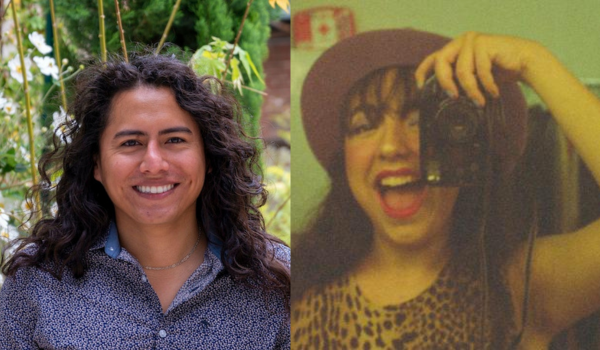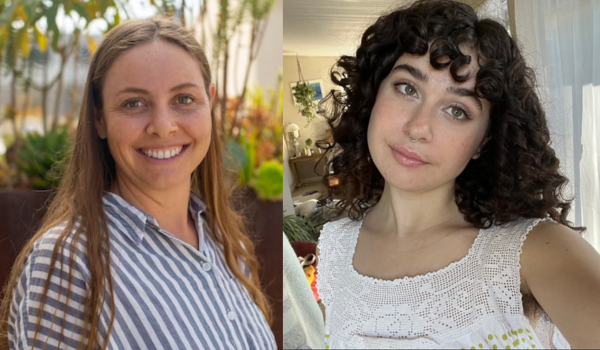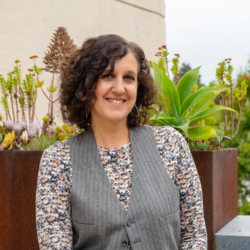THI Undergraduate Public Fellows Rebecca Snyder and Sara Sotelo shine at the Santa Cruz Museum of Art & History
The Humanities Institute has a long and thriving partnership with the Santa Cruz Museum of Art & History (MAH) that has included organizing exhibitions, putting on events, and connecting UCSC campus life with the local community. As part of these collaborations, UCSC graduate and undergraduate students have also had the opportunity to bring their humanities academic training to work at the MAH through THI’s Public Fellows program. In 2022-2023, two undergraduate students were THI Public Fellows at the MAH: Rebecca Snyder, a recent graduate with majors in History of Art and Visual Culture and Literature (with a Creative Writing concentration), worked as the Assistant Archives Coordinator; Sara Sotelo, a recent graduate with majors in History and Education, worked as the Assistant Education Coordinator as part of the MAH’s Exhibitions & Programs team.

Sotelo spent the year working closely with her mentor, Oscar Paz, the Education & Outreach Manager at the MAH. They collaborated to manage MAH’s field trips, develop tour programming, and communicate with teachers, schools, and community groups. For Sotelo, the position brought together “a lot of my favorite things: museums, art, history, and being a tour guide.” Sotelo has led a host of student tours, mostly at the 3rd grade level, both at the MAH and in Evergreen Cemetery. She was especially excited about the chance to work with children and “to be able to spark a little bit of historical joy.”

Snyder was paired with the MAH’s Archives Specialist Jessie Durant, who leads the museum’s efforts to collect, preserve, arrange, describe, and provide access to the MAH’s historical collections. Snyder has “always been interested in history and art” and found the internship to be the perfect fit. Over the course of the year, Snyder has been working on the MAH’s Queerstory project, which is supported by a grant from the California State Library to to digitize the MAH’s entire LGBTQ+ collection and design exhibits and programs around the materials. Snyder’s tasks have included digitizing each item, producing the associated metadata, and cataloguing the entries into MAH’s archival catalog system in a public, online, searchable portal.
Both Sotelo and Snyder have benefitted from close mentorship. For his part, Paz approached his collaboration with Sotelo from a perspective of open curiosity, tapping into Sotelo’s prior experience and knowledge with the goal of “fostering confidence and self-awareness.” Paz shares, “My mentorship style is very natural. I want to treat you as a friend who is coming over to learn about what we do at the museum. I like to get to know you and learn about how your experiences influence your skills. I ask a lot of questions since this helps me give you tasks that I know you will be able to complete. If there are projects or tasks that you feel are out of your comfort zone, we can work on them together.” Important for Paz is making the partnership feel like a mutual learning experience: “I want to make it clear that I am also learning with you. I do not know everything but together we can figure it out.”
The absolute biggest skill that I learned at the MAH was to believe in myself.
Sotelo felt that Paz’s open and laid-back approach to the collaboration encouraged her to “learn content on the fly and trust my abilities.” She goes on, “Oscar was amazing to work with. He was so supportive of me when I needed to learn something new or when I wanted to take on a new task. He wanted me to be able to explore what I was passionate about.” Sotelo also spent time observing Oscar giving tours, which helped her adapt her own tour guide pedagogy: “I really wanted to learn more about what it took to really deliver quality historical lessons outside of the traditional classroom so I would often be a fly on the wall when Oscar was talking to see how I could spin his words into something that I would enjoy doing in my own tours.” Sotelo found her self-confidence grew enormously in the position: “The absolute biggest skill that I learned at the MAH was to believe in myself. I had to believe that I could learn new skills, that I could manage large groups of people.” With Paz’s mentorship, she successfully did just that. Paz remarks that Sotelo’s progress over the course of the fellowship was really apparent: “working together gave Sara the opportunity to realize how knowledgeable she already was about public speaking and community engagement and then put it into practice.”

Snyder, too, has developed a mutually enriching collaboration with her mentor, Durant. For Durant, mentoring Snyder was about both providing clear structure through “a project framework and resources that clearly lay out the expectations and goals,” and taking time to “foster a deeper understanding and appreciation of the role archives play within a community.” Because Snyder was new to archival work, she found this approach particularly helpful: “Working with Jessie has been a great experience. She’s an expert at what she does, and helped me understand the nature of archives and the workflow of the project in a really digestible and interesting way.” The relationship made Snyder feel confident to “ask a lot of questions and dive in head first.” Snyder and Durant also cultivated a mutual interest in the niche aspects of digitizing the LGBTQ+ archive, sharing about the most interesting personal ads they found in old newspapers, and discussing the ways those stories create an intimacy with the past and present Santa Cruz queer community. Durant was excited to see Snyder grow in competence and confidence during the fellowship: “I also learned from Rebecca who provided feedback on the processes and has become an expert on the collection.” Snyder remains in her role at the MAH as Archives Assistant as she completes the Queerstory project.
Learning about museums and how they function and then actually doing it through the Public Fellows Program was a really fulfilling experience.
One of the most fruitful aspects of the THI Public Fellows program for Sotelo and Snyder has been the opportunity to extend their classroom experiences and apply their academic skills to their museum roles. For Snyder, who studied Art History and Literature, she found herself drawing connections between her archival work and her Spring seminar on museum studies: “I was able to share with my museum studies class the crossover between what we were learning and my experience doing it at the MAH. Learning about museums and how they function and then actually doing it through the Public Fellows Program was a really fulfilling experience.” Sotelo also found that the fellowship aligned with her classroom work. As a History and Education major, she was able to deepen her interest in “alternative education, looking especially at how students learn history” and transform her theoretical knowledge into practical expertise by developing and leading student tours at the MAH. As Sotelo recounts, “History is often a subject that students are not engaged with; they think it’s boring. But when they go to a museum that changes for them. I was/am deeply fascinated in that shift. I wanted to be a part of that shift, making history fun and interesting and tying in art because art is so central in history.” As Sotelo says, “All of this came together through the Public Fellows Program at the MAH.”
Doing the fellowship is one of the best things I’ve done as an undergraduate.
Sotelo encourages other students to pursue THI Public Fellowships for the opportunity to “remember that we as students are a part of this community.” As she says, “It is so easy to fall into the bubble of ‘students’ here in Santa Cruz, but to work with local institutions we are reminded that the work that we want to do, like museum education, has an impact on a community. It is such a great feeling to know you are part of a greater community.” Similarly, Snyder hopes future students will “take advantage of these kinds of opportunities” in order to “learn some amazing real life skills and get to see what having a job is like.” She also hopes future participants in the program will feel the pride she does in contributing to large scale projects: “I’ve met a lot of amazing people, both at the MAH and through research with the grant, and the work I’ve done has become the thing I’m most proud of. Doing the fellowship is one of the best things I’ve done as an undergraduate.”
The Public Fellows program experience at the MAH has shaped Sotelo and Snyder’s future plans as well. Sotelo aspires to” work in museums and historical institutions just like this in order to create meaningful impacts on the people around me through educational (if not historical or artistic) programming.” Snyder also hopes to keep working at museums. As she says, “I’m crossing my fingers I can keep doing work like this somewhere else.”
The MAH has been a perfect place to grow our THI Public Fellows program.
The team at THI has been so pleased with the public fellows’ successful experiences and is excited to continue collaborating with the MAH. “We knew the inspiring leaders at the museum would be terrific mentors” says Saskia Nauenberg Dunkell, THI Research Programs and Communications Manager. “The MAH has been a perfect place to grow our THI Public Fellows program to provide opportunities for humanities students to work in our community and open new doors for their futures.”

Marla Novo, MAH’s Director of Exhibitions & Programs, Novo sees a bright future as the MAH and THI evolve together: “I’m thrilled to continue building this important partnership. It brings our community together through public scholarship, local history, and shared experiences.”
As she explains, “We loved working with Rebecca Snyder and Sara Sotelo this past year. It’s a privilege to share opportunities with these undergrads. We create experiences that expand the students’ academic interests and community engagement. The added bonus is that we learn from them as much as they learn from us.” Novo sees a bright future as the MAH and THI evolve together: “I’m thrilled to continue building this important partnership. It brings our community together through public scholarship, local history, and shared experiences.”
Motivated undergraduate students should look for an opportunity to serve as a Public Fellow at the Museum of Art and History later this year.
THI’s 2022-2023 Undergraduate Public Fellowships are generously supported by the Helen and Will Webster Foundation.
Banner Image: Santa Cruz Museum of Art and History
